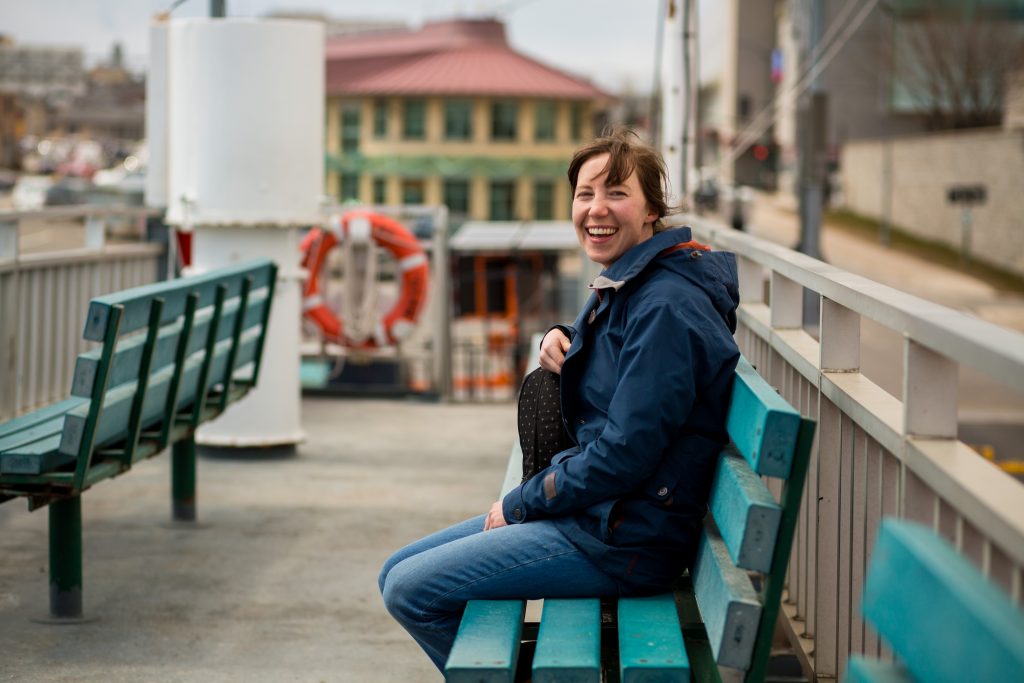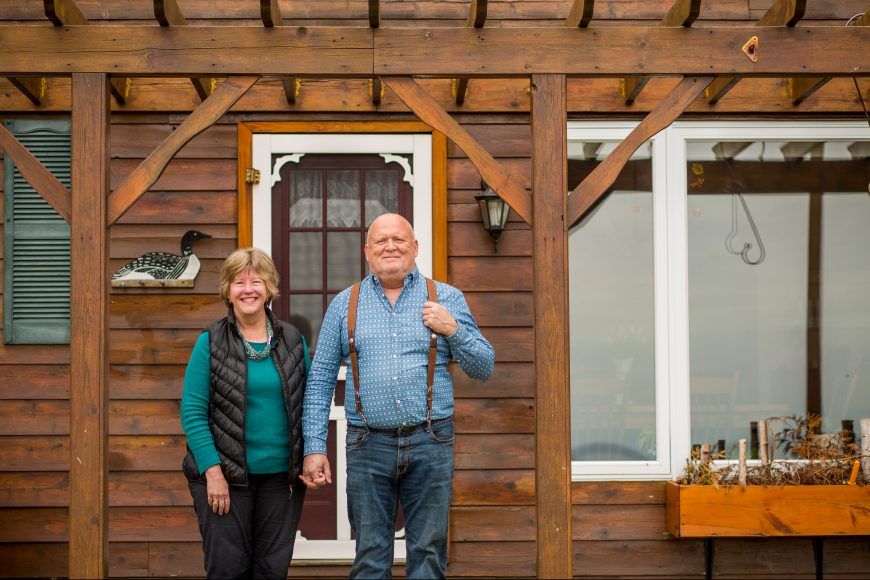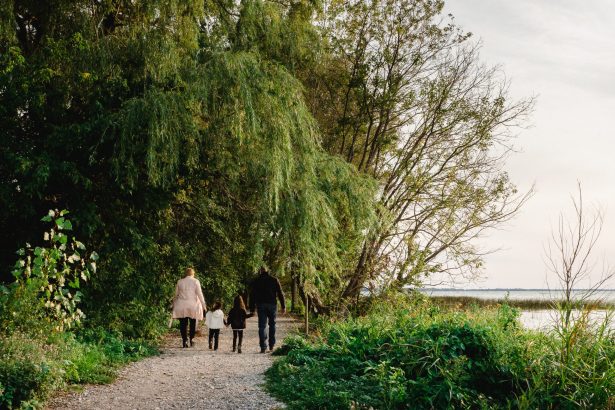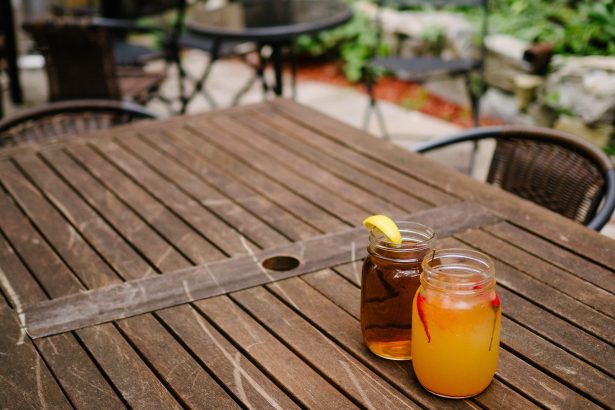Locals on the joys and difficulties of life on Amherst, Wolfe, Simcoe and Howe islands.
Bordering the edges of Kingston, along Lake Ontario and the St. Lawrence River, lie Amherst Island, Wolfe Island, Simcoe Island and Howe Island. Accessible only by water, each is rich with its own history, art, folklore, landscape, wildlife and community. Yet, although the islands are considered part of Kingston in Ontario’s provincial electoral districts, and even though many island inhabitants commute to town for work, they are often overlooked when it comes to citywide dialogue and identity – and sometimes forgotten altogether. For many islanders, in fact, their home feels like one of the Kingston area’s best-kept secrets.
Amherst Island
Bearing a slight resemblance to the shape of a squid when seen from the air, Amherst Island is located 10 kilometres west of Kingston on Lake Ontario. Measuring over 20 km in length, Amherst is one of the largest islands on the Great Lakes.
Originally inhabited by Indigenous Peoples, in 1788 Amherst Island was granted by the Crown to Sir John Johnson, a British Loyalist leader during the American Revolution, provincial military officer and Canadian politician. In 1823, Sir Johnson’s daughter, Catherine Marie Bowes, gained control of the island. But – rumour has it – she then lost possession in a card game in Ireland to an Anglo-Irish aristocrat named Stephen Moore, 3rd Earl Mount Cashell.
Mount Cashell brought over many Irish immigrants to the island, in hopes of strengthening the transatlantic grain trade with a prosperous farming industry. Following his evangelical belief in human improvement, religion was a strong influence on the island: to this day, there are three churches on the island, for a population of just 450 in the winter and 800 in the warmer months.
One of these inhabitants is lifelong resident Keith Miller, a seventh-generation retired dairy farmer and one of the oldest male residents on the island.
Miller is a volunteer at the local museum. He helps assemble and build old farm parts for the exhibits.
“I was fortunate to live just in the right span of time – we started my farming career with horses and ended it [with] automatic controls on sprayers … It changed a lot in 70 years,” says Miller.
“There’s only one dairy farm left. When I was (farming) there were about 15. In 1948 there were 96 milk producers on the island.”
Miller says he’s seen Amherst Island change drastically over his 77 years – including the loss of farms and the fishing village. For instance, the island didn’t have a winter ferry until 1975, and Miller remembers building roads on the ice to drive across to the mainland.
“We’d chop holes in the ice and put cedar trees in the holes, let them freeze so they had a road to follow, so you wouldn’t get lost in a blizzard,” explains Miller. “You could get lost out there in two seconds.”
Though ferry life is unique for most, Miller says you learn to live with it.
“I never worry about it a lot because there’s always another boat in an hour.”
He has a live radio show on Amherst’s volunteer-run radio station, CJAI 92.1 FM, called “150 Years Made in Canada.” Miller and his co-host, Janet Scott, named the show after their combined ages, which added up to 150 and happened to coincide with the 150th anniversary of Confederation.
Every Tuesday morning, Miller and Scott play strictly Canadian music, read from local history books and give updates on the goings-on of the island. The two are close friends, having met on the museum board years ago and bonded over their love of island history.
Scott, a retired school teacher, lived in Ottawa and Kingston before moving to Amherst Island in 1984. She and her family are avid bird-watchers and were looking for a home in the country where they could explore and spot more species. Known as the “Bird Lady” of Amherst Island, Scott gives guided tours, has a radio program on birds and writes about them in island newsletter The Beacon.
Scott says she loves Amherst’s sense of community.
“I was amazed when we moved here. No one would ever leave you on the side of the road when they saw your car,” she says. “I lived in Kingston for 14 years and it was so different to come here. The snowplows stopped one day to see if I was alright. That didn’t happen in Kingston Township, you know?”
For over 20 years, Miller has been working part-time as the landfill site attendant at the island dump, in which, he says, he also functions as a makeshift information booth.
“This job, I know everybody. You have to be close and personal because I have to know who you are and how much garbage you have. Eventually you get to know them all. They all ask me something too – like, they all want to know who you get to do a well and who you get to fix [things],” says Miller.
“When they’re new here, this is the place to come. He’s the guy to ask if you need help,” quips Scott, adding, with a laugh, “Do you know any dump managers that keep a bird feeder? I can come here and watch his bird feeder.”
Unfortunately, for all the island’s togetherness, Miller says he’s never seen the community as fractured as it is today. Controversy surrounding the Amherst Island Wind Project has caused a great divide among residents. Operated by Windlectric Inc., the project is an initiative by the Government of Ontario to promote the development of renewable energy with the construction of 27 wind turbines on the island.
Though Scott and Miller are on ”different sides” of the project, they both make it a point to not let their differing views interfere with their friendship.
“It has totally separated the island,” says Miller. “It’s made it really hard. It will be slow but it will have to get better because all of us will die. The young kids aren’t going to carry on a grudge like that.”
“Right now it’s sad to see neighbour against neighbour, sometimes in the same family. That’s been sad,” interjects Scott. “Like Keith says, we just have to wait it out and hopefully the young people will forgive.”
Wolfe Island

Originally named Ganounkouesnot (Long Island Standing Up), Wolfe Island was part of the traditional hunting land of the Tyendinaga Mohawk People. Situated at the entrance of the St. Lawrence River, it’s the largest of the Thousand Islands, running 29 km wide. The island can be accessed by ferry from Kingston and, across the border, from Cape Vincent, New York.
Wolfe Island is the most populated island with over 1,400 residents in the winter (a number that can double, or sometimes even triple, in the summer). It’s also the most accessible to Kingston’s downtown core, allowing it to function more like a small adjunct village and less like the remote country living of, say, Amherst Island. During the summer, Wolfe Island is a haven for tourists, campers and cottagers. The hub of the island is Marysville, with its popular grill, bakery, grocery store, pizzeria and coffee shop.
Emilie Steele says she fell in love with the island and its eclectic art scene after attending the annual Wolfe Island Music Festival as a Queen’s student. Born and raised in a Guelph suburb, she moved to the island in 2014, a few years after graduating.
Now 30 years old, Steele says that living on the island offers the best of both rural living and vibrant city life. She says living so close to downtown is like “having Kingston in your backyard.”
That dual quality has helped Steele craft a lifestyle that allows her to work seasonally as a landscaper and gardener and, in the winter, part-time at a local bar on Queen’s campus. The off-time allows her to focus on her work as an artist and musician.
“It is quite a creative little alternative place. You go to the winter craft sale and (see) your neighbours that you had no idea were nestling away like I am, making beautiful original artwork,” says Steele.
“It’s the small, little moments that make island life,” she adds. “I’m not an active religious person, but on Sunday morning, my favourite thing is just (when) the bells start ringing … then they go off-tempo and it has the aesthetic of a charming little village. Our neighbour’s dog, Charlie, he howls with them. It’s just this beautiful moment that happens every Sunday morning.”
Steele says the summer months bring a vibrancy to the island, which helps make up for the quieter winter months.
“When the boat comes back to the village, (if) there’s a rainbow over Marysville that day, it doesn’t matter if it’s a grey day,” she says. “They kind of give the place the pulse and the energy.”
In November 2017, the Ontario government announced plans to build two new ferries for Wolfe Island and Amherst Island, an initiative to help make commuting easier and more reliable. The Wolfe Island Ferry, expected to be delivered in 2020, will carry 75 vehicles, an addition Steele believes will help bring even more tourists and economy to the island.
Brian MacDonald, a retired sixth-generation cattle farmer and lifelong resident of Wolfe Island, echoes similar sentiments about the new ferry.
MacDonald is the current treasurer for the Wolfe Island Historical Society. He and his wife, Brenda MacDonald, are also active members of the Nine Mile Point Lighthouse Preservation Society. The lighthouse sits on Simcoe Island (just off the northwest tip of Wolfe Island) and is one of the oldest active lighthouses on the Canadian side of the Great Lakes, dating back over 200 years. Brenda, Brian and other local residents created the non-profit after the federal government’s decision to sell off hundreds of lighthouses across the country. The society submitted a bid to purchase the lighthouse and has been “patiently waiting” for a decision since 2015.
Brenda MacDonald, a retired librarian and farmer, was born and raised on Simcoe Island, and her mother, Lois Eves, and brother, Donald Eves, still reside there.
“When I was really small, my best friend’s dad was one of the lighthouse keepers. I slept over,” says MacDonald. “It [was] hard to sleep because of the foghorn. You’d be in the bedroom and you’d hear ‘hoooonk.’ My dad did some fill-in (as a lighthouse keeper) and some of the family, grandpa Eves, he ran the light for a while.
“There’s been two bids that have gone in: ours, which is a not-for-profit, and the other one is a private bid. I think it would be tragic if we lost public access to what I think is a national treasure,” says MacDonald. “It’s one of those things that make you feel like you want to protect your heritage.”
Simcoe Island
The smallest of the four islands, Simcoe Island runs only six km long and is accessible by a three-car cable ferry from Wolfe Island.
In 1792, the lieutenant governor of Upper Canada, John Graves Simcoe, named the stretch of islands along the St. Lawrence River after generals at the Battle of the Plains of Abraham – James Wolfe, Jeffery Amherst and William Howe – with the last being made Simcoe Island.
Today, only 20 full-time residents populate the island. Lois Eves, 87, moved to Simcoe Island from Kingston in 1959 after marrying an islander. She and her family lived on the island before it even had a ferry: in fact, she says, before 1965, if you wanted to get to Kingston, you’d take a fishing boat.
“The time I lived in Kingston was probably the loneliest time,” remembers Lois. “I lived in a second-floor apartment. There were hundreds of people walking by my door every day, but I didn’t know any of them.”
Lois and her husband owned a farm and a commercial fishing business. Her son, Donald Eves, still lives on the island with his young daughter. He owns a small cattle farm and is the captain of the Simcoe Ferry, a job he’s held for 33 years.
“There were a lot of farms on Simcoe at one time. There were over 80 when we had ours,” says Lois.
Donald says the lack of transportation in the winter is the hardest part about living on the island. In the winter months, residents have to walk or drive across the ice to get to Wolfe Island. Donald says he makes sure to prepare for several weeks in advance, in case of a storm or melting ice. Often, he has to worry about his daughter crossing the ice to get to school.
Despite having such a small population, Donald and Lois say they never consider moving off the island.
“I never feel lonely,” says Lois. “My husband passed away 10 years ago, and I’ve stayed on the island since then. It’s home.”
Howe Island

Located in the St. Lawrence River, east of Kingston, Howe Island measures 13 km long. The main channel of the St. Lawrence River passes to the south of the island; the Bateau Channel passes on the north, between it and the mainland. Howe Island was originally named Ka-ou-enesegoan by local Iroquois.
Two ferry services connect Howe Island to the mainland. A county-operated ferry connects from the west from the community of Pitts Ferry. The other township-operated foot-ferry (mainly used for standing passengers) connects to Gananoque from the west. You can drive the entire length of the island without having to turn back and retrace your route.
With a population of 450 in the winter and 800 in the summer, Howe Island comprises mainly farmers, cottagers and retirees. There is very little business on the island and limited public space.
Retired registered nurse Bonnie Ottenhof has lived on Howe Island for most of her life. She comes from four generations of islanders, growing up in a family of farmers. She moved to the old Township of Kingston shortly after getting married – only to move back after having children.
Ottenhof describes her life growing up on Howe Island as quiet but always busy. She recalls summers spent swimming and winters of pond skating and Christmas concerts in one of the three single-room schoolhouses that were on the island.
“The folks on the island were very keen that we had an education, us kids,” says Ottenhof. “My older brother and sisters rode in a hearse to school. That was [their] school bus – it still had the plush velvet seats. When it was my turn to go to high school, I rode in a converted cattle truck. That’s all the township could afford at the time.”
The transition from a farming community to an island of mainly large and wealthy summer homes has Ottenhof feeling conflicted.
“As you drove in you must have seen those magnificent homes, so that’s what the island is about right now,” she says. “A lot of retired [islanders] with money. There were very few cottages until the ‘60s. It was halftone trucks and hay wagons and tractors, and now it’s Escalades and Lexuses and service trucks on the ferry.”
“The sense of community, to my way of thinking, has been lost. As a farming community you got together because you needed that socialization. Now it’s more … fractured. We don’t have a community hall where I could go down in the morning, pick up a couple of the old gals, and we could have a coffee.
“I’m here on my own now. I lost my husband two years ago. Here I am. I’m in the last age of my life and trying to figure out, do I stay?” says Ottenhof, adding that a number of widows on the island face similar challenges.
She has lived in a beautiful farmhouse since 1979, which she calls the “hub of the Ottenhof clan.” The view from her kitchen deck is the MacDonald Farm, across the water on Wolfe Island.
“My father would always say you should never be a burden to your children, and I believe that. I’m still independent. I’m still driving. And as long as I can do that then I’ll stay,” says Ottenhof.
She does worry about the future of the community, however.
“I don’t know what will happen when all us old dusties die off. Who will take over these houses?” she asks. “There will always be rich people from Toronto coming over to buy land on Howe Island, to ‘nest’ in the islands, as they like to say.”
Wendy and David Jones are also retired but are fairly new to the island. After 30 years in Australia, they moved back to Canada in 2004. They now own the Howe Island B&B, which has been in operation for 10 years.
Wendy says they run the business not for the income but because of the people they get to meet from all corners of the world.
“Just the slice of life that walks in your door, it’s amazing,” says Wendy.
The couple say they fell in love with the island as soon as they entered their 200-year-old farmhouse for the first time. While Wendy agrees that newcomers are outnumbering those with longer ties, she says that’s a testament to the island’s charms and not a cause for concern.
“You think you’re just buying a home when you get here, and then you realize you’re in a community of like-minded people who love the island for what it is. I think initially, the people that have been born and brought up here think, ‘Oh god, here comes change.’
“We just love it the way it is – and the last thing we’d want to do is change it.”
This article was originally published in Kingston Life, a bi-monthly local magazine that explores all things Kingston. For more great articles, please visit: www.kingstonlife.ca.




